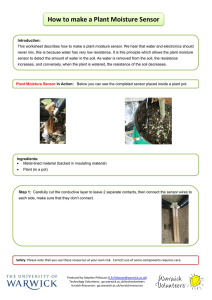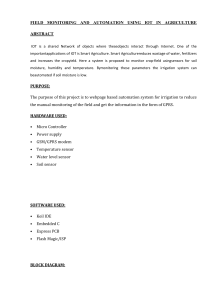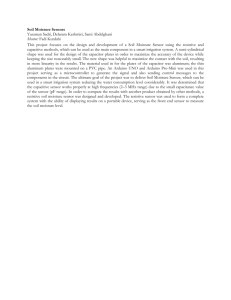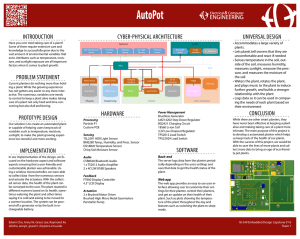IRJET- Analysis of IoT based Wireless Sensors for Environmental Monitoring in Agriculture
advertisement
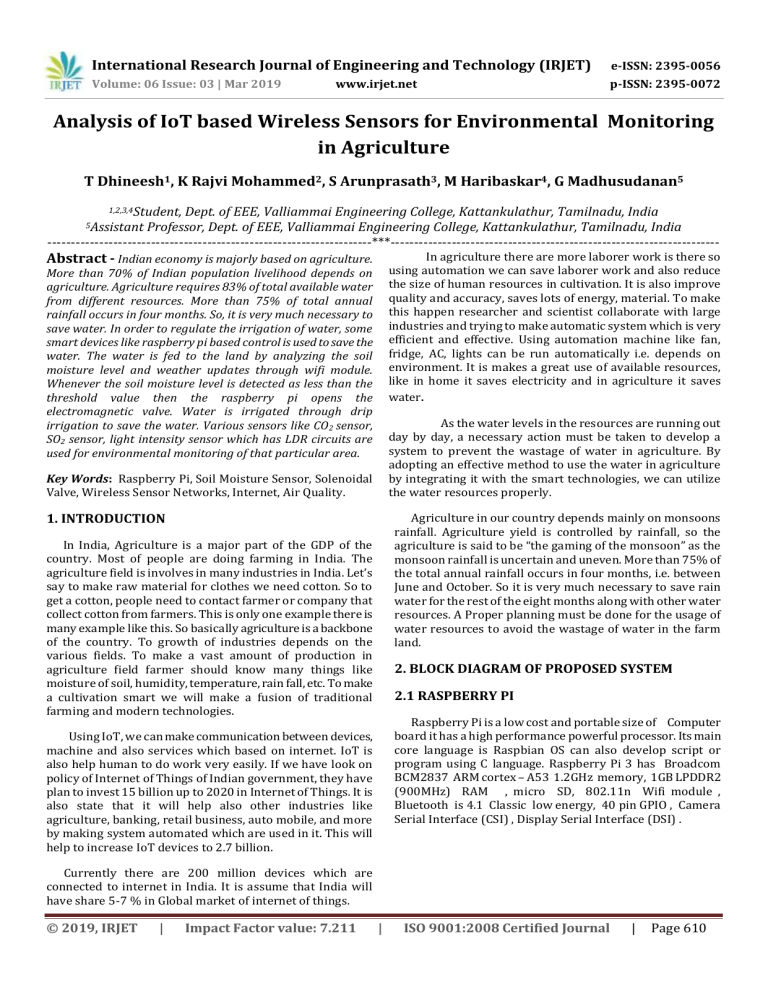
International Research Journal of Engineering and Technology (IRJET) e-ISSN: 2395-0056 Volume: 06 Issue: 03 | Mar 2019 p-ISSN: 2395-0072 www.irjet.net Analysis of IoT based Wireless Sensors for Environmental Monitoring in Agriculture T Dhineesh1, K Rajvi Mohammed2, S Arunprasath3, M Haribaskar4, G Madhusudanan5 1,2,3,4Student, Dept. of EEE, Valliammai Engineering College, Kattankulathur, Tamilnadu, India Professor, Dept. of EEE, Valliammai Engineering College, Kattankulathur, Tamilnadu, India ---------------------------------------------------------------------***---------------------------------------------------------------------5Assistant Abstract - Indian economy is majorly based on agriculture. In agriculture there are more laborer work is there so using automation we can save laborer work and also reduce the size of human resources in cultivation. It is also improve quality and accuracy, saves lots of energy, material. To make this happen researcher and scientist collaborate with large industries and trying to make automatic system which is very efficient and effective. Using automation machine like fan, fridge, AC, lights can be run automatically i.e. depends on environment. It is makes a great use of available resources, like in home it saves electricity and in agriculture it saves water. More than 70% of Indian population livelihood depends on agriculture. Agriculture requires 83% of total available water from different resources. More than 75% of total annual rainfall occurs in four months. So, it is very much necessary to save water. In order to regulate the irrigation of water, some smart devices like raspberry pi based control is used to save the water. The water is fed to the land by analyzing the soil moisture level and weather updates through wifi module. Whenever the soil moisture level is detected as less than the threshold value then the raspberry pi opens the electromagnetic valve. Water is irrigated through drip irrigation to save the water. Various sensors like CO 2 sensor, SO2 sensor, light intensity sensor which has LDR circuits are used for environmental monitoring of that particular area. As the water levels in the resources are running out day by day, a necessary action must be taken to develop a system to prevent the wastage of water in agriculture. By adopting an effective method to use the water in agriculture by integrating it with the smart technologies, we can utilize the water resources properly. Key Words: Raspberry Pi, Soil Moisture Sensor, Solenoidal Valve, Wireless Sensor Networks, Internet, Air Quality. 1. INTRODUCTION Agriculture in our country depends mainly on monsoons rainfall. Agriculture yield is controlled by rainfall, so the agriculture is said to be “the gaming of the monsoon” as the monsoon rainfall is uncertain and uneven. More than 75% of the total annual rainfall occurs in four months, i.e. between June and October. So it is very much necessary to save rain water for the rest of the eight months along with other water resources. A Proper planning must be done for the usage of water resources to avoid the wastage of water in the farm land. In India, Agriculture is a major part of the GDP of the country. Most of people are doing farming in India. The agriculture field is involves in many industries in India. Let’s say to make raw material for clothes we need cotton. So to get a cotton, people need to contact farmer or company that collect cotton from farmers. This is only one example there is many example like this. So basically agriculture is a backbone of the country. To growth of industries depends on the various fields. To make a vast amount of production in agriculture field farmer should know many things like moisture of soil, humidity, temperature, rain fall, etc. To make a cultivation smart we will make a fusion of traditional farming and modern technologies. 2. BLOCK DIAGRAM OF PROPOSED SYSTEM 2.1 RASPBERRY PI Raspberry Pi is a low cost and portable size of Computer board it has a high performance powerful processor. Its main core language is Raspbian OS can also develop script or program using C language. Raspberry Pi 3 has Broadcom BCM2837 ARM cortex – A53 1.2GHz memory, 1GB LPDDR2 (900MHz) RAM , micro SD, 802.11n Wifi module , Bluetooth is 4.1 Classic low energy, 40 pin GPIO , Camera Serial Interface (CSI) , Display Serial Interface (DSI) . Using IoT, we can make communication between devices, machine and also services which based on internet. IoT is also help human to do work very easily. If we have look on policy of Internet of Things of Indian government, they have plan to invest 15 billion up to 2020 in Internet of Things. It is also state that it will help also other industries like agriculture, banking, retail business, auto mobile, and more by making system automated which are used in it. This will help to increase IoT devices to 2.7 billion. Currently there are 200 million devices which are connected to internet in India. It is assume that India will have share 5-7 % in Global market of internet of things. © 2019, IRJET | Impact Factor value: 7.211 | ISO 9001:2008 Certified Journal | Page 610 International Research Journal of Engineering and Technology (IRJET) e-ISSN: 2395-0056 Volume: 06 Issue: 03 | Mar 2019 p-ISSN: 2395-0072 www.irjet.net 2.3 SOLENOIDAL VALVE This valve is also called electromagnetic valve as it resembles the electromagnetic principle of solenoid. It acts as a gate valve for the water flow in pipes. Whenever an impulse is given from raspberry pi then solenoid starts to energise and thus it opens the valve by attracting it. And when the port goes LOW the solenoid closes the valve. This acts as a flow sensor for this system. 2.2 SOIL MOISTURE SENSOR In IoT (Internet of Things) sensor is important part of the system, without it system cannot be working like heart in human body. Using sensor, it takes physical parameter from world and convert it into electronic system and send it to main controller for ex. Raspberry Pi. One of the sensor which this system used is soil moisture sensor. This sensor is used for measuring moisture level of soil. Output of this sensor can be analog signal or it can be digital signal. It has two cooper electrodes which is used for measure moisture from the soil. 2.4 LIGHT INTENSITY SENSOR As agriculture greatly depends on sunlight, there is need of measuring the intensity of sunlight. Which in turn predicts the healthy nature of plants in the field. Thus to measure the intensity of light an Light sensor is used. It has LDR circuits which is interfaced with Raspberry Pi for continuous monitoring of sunlight in the field. By measuring the intensity of sunlight everyday we can identify the health of plants usingIoT from a far place. To make cultivation better, farmer have to know moisture level of soil and this sensor is doing same things, so soil moisture sensor is important for farming related application. Actually if farmer knows exact moisture level of soil it will be helpful to saving water and also improve the quality of plant. Because if it take care of plant during its growing stage it will be give good quality product. 2.5 CO2 AND SO2 SENSOR For environmental monitoring of that particular agricultural field , various air quality sensors are used (i.e.,) CO2 and SO2 sensors. The level of CO2 is essential in determining the plant growth . Then SO2 is toxic for plants and others living forms. Monitoring these two gases is essential in smart way of doing agriculture using IoT. © 2019, IRJET | Impact Factor value: 7.211 | ISO 9001:2008 Certified Journal | Page 611 International Research Journal of Engineering and Technology (IRJET) e-ISSN: 2395-0056 Volume: 06 Issue: 03 | Mar 2019 p-ISSN: 2395-0072 www.irjet.net 3. METHODOLOGY 3.1 GENERAL PROCEDURE Drip irrigation system is automated by providing full controlling capability to the farmer through internet. Farmer can control the system from anywhere through internet. The main feautres of the proposed system are: 1. 2. 3. 4. Farmers are able to ON/OFF the drip using internet, based on the level of soil moisture. The light intensity is also measured using LDR circuits which gives the essential data of the intensity of light on the field. The system is also operated in solar power supply. So that it will continuously sends the data with on power cut also. 12V solar panel is used. Raspberry Pi runs 14 hours per day. The air quality is monitored using CO2 and SO2 sensors to check the pollution level of the air in agricultural land. It helps to verify the healthiness of the plants. The air quality level is continuously monitored by raspberry pi through wifi module. 2.6 BLOCK DIAGRAM Sunlight is essential for the growth of plants. Thus to measure the sunlight received light intensity sensor with LDR circuits is used which is sent to raspberry pi through wifi module. 3.2 ALGORITHM Measuring and Monitoring Soil moisture Step 1: Initialize all modules by providing power Supply. Step 2: Read the soil moisture level. Step 3: Check the moisture level (less than or more threshold value). Step 4: If moisture level is more than an threshold value, stop drip flow. Step 5: If moisture level is less than a lower threshold value, start drip flow. Step 6: Go to Step 3. © 2019, IRJET | Impact Factor value: 7.211 | ISO 9001:2008 Certified Journal | Page 612 International Research Journal of Engineering and Technology (IRJET) e-ISSN: 2395-0056 Volume: 06 Issue: 03 | Mar 2019 p-ISSN: 2395-0072 www.irjet.net allows cultivation in places with water scarcity thereby improving sustainability. Raspberry pi is an important part of system which is handle the processing and working. In this proposed system we used many sensors like soil moisture to measure moisture of soil, light intensity sensor to measure the sunlight,CO2 sensor to measure the CO2 level. WIFI module is used to notify the farmers about current state of the farms. 6. ACKNOWLEDGEMENT The authors would like to thank the anonymous reviewers for their constructive comments. We also would like to thank our institution for their support to carry out our project in the laboratory. 7. REFERENCES [1] [2] 4. HARDWARE IMPLEMENTATION [3] The hardware of the proposed work consists of aspberry Pi interfaced with various sensors like soil moisture sensors, CO2 sensor, temperature and humidity sensor, light intensity sensor and a solenoidal valve. A battery is used to power the 12V solenoidal valve. A tapper circuit is used to convert the 12V supply into various number of 5V supply to power the sensors. A Wifi dongle is used to connect the Raspberry Pi with the internet. [4] [5] [6] [7] [8] 5. CONCLUSION The automated irrigation system implemented was found to be feasible and cost effective for optimizing water resources for agricultural production. This irrigation system © 2019, IRJET | Impact Factor value: 7.211 [9] | Subhashree Ghosh, Sumaiya Sayyed, Kanchan Wani, Mrunal Mhatre, Hyder Ali Hingoliwala, “Smart Irrigation: A Smart Drip Irrigation System using Cloud, Android and Data Mining” 2016 IEEE International Conference on Advances in Electronics, Communication and Computer Technology (ICAECCT) Pune India. Dec 2-3, 2016. S. Darshna, T.Sangavi,Sheena Mohan, A.Soundharya, Sukanya Desikan “Smart irrigation System” IOSR Journal of Electronics and Communication Engineering (IOSR-JECE) , Volume 10, Issue 3, Ver. II (May -Jun.2015). Chandan kumar sahu, pramitee behera “A low cost smart irrigation control system” IEEE sponsored 2nd international conference on electronic and communication system 2015. M. Srbinovska, C. Gavrovski, V. Dimcev, A. Krkoleva, V. Borozan, “Environmental parameters monitoring in precision agriculture using wireless sensor networks” J. Clean. Prod., 88 (2015), pp. 297-307. Srishti rawal “IOT based smart irrigation system” international journal of computer application, Volume 159 – Feb 2017. Pranita A. Bhosale, Prof. V. V. Dixit, “Water SavingIrrigatio Automatic Agricultural Controller”, International Journal of Scientific & Technology Research volume 1, Issue 11, December 2012. Pavitra D.S and M.S Srinath “GSM based automatic irrigation control system for efficient use of resources and crop planning by using an android mobile” IOSR journal of mechanical and civil engineering Volume 11, Issue 4 ver. I (Jul-Aug 2014). Prabhu, Boselin and Pradeep, M. and Gajendran, E., “An Analysis of Smart Irrigation System Using Wireless Sensor Network” Star Vol.5 Issue 3(3), March (2017). P. Divya Vani and K. Raghavendra Rao “Measurement and Monitoring of Soil Moisture ISO 9001:2008 Certified Journal | Page 613 [10] International Research Journal of Engineering and Technology (IRJET) e-ISSN: 2395-0056 Volume: 06 Issue: 03 | Mar 2019 p-ISSN: 2395-0072 www.irjet.net using Cloud IoT and Android System” Indian Journal of Science and Technology, Vol 9(31), DOI: 10.17485/ijst/2016/v9i31/95340, August 2016. E.Sowmiya, S.Sivaranjani “Smart System Monitoring on Soil Using Internet of Things (IOT)” International Research Journal of Engineering and Technology (IRJET), Volume: 04 Issue: 02 | Feb (2017). © 2019, IRJET | Impact Factor value: 7.211 | ISO 9001:2008 Certified Journal | Page 614
